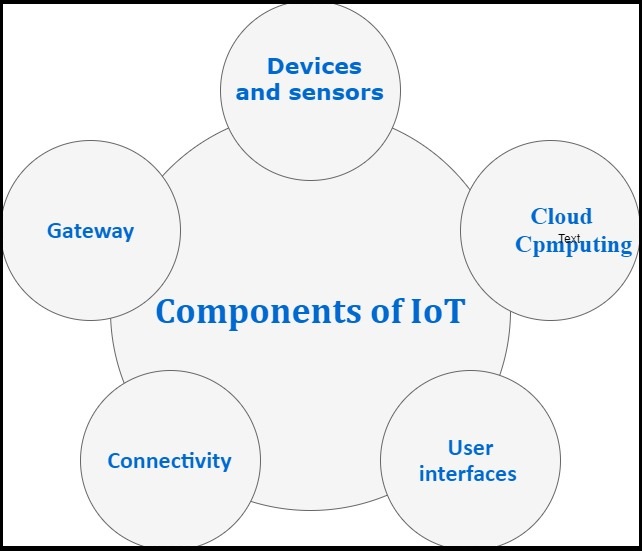Components of IoT
There are the following components used in IoT:
- Devices and sensors
- Cloud Computing
- User interface
- Networking connection
- Gateway

Devices and sensors
Devices and sensors are the components of the connectivity layer. These smart sensors continuously collect data from the environment and transmit it to the next layer. For example, our phone is a device with multiple sensors such as GPS, camera, motion, etc.
The latest techniques in semiconductor technology enable intelligent micro-sensors to be produced for various applications.
There are some common sensors are as follows:
- Temperature and thermostats sensors
- Pressure sensors
- Humidity / Moisture level
- Light intensity detectors
- Moisture sensors
- Proximity detection
- RFID tags
Cloud Computing
IoT systems send huge data from devices, and these data must be managed efficiently to generate meaningful results. IoT technology uses the cloud to store a large amount of data. It provides tools for collecting, processing, and storing data. The data is easily available and accessible remotely through the internet. It also provides a platform for analysis. The IoT cloud is an advanced network of high-performance servers for high-speed processing of large amounts of data.
User interface
User interfaces are the physical and visible part of the IoT system accessible to users. User interface design is more important in today's competitive market, as it often allows the user to choose a particular device or appliance. Users will be interested in buying new smart devices if it is effortless to use and compatible with current wireless standards.
Modern technology offers a lot of interactive design to facilitate complex tasks in simple touch screen controls. Multi-colored touch screens have replaced the hardware switches on our devices, and the trend is on the rise for almost all smart home devices.
Networking connection
Internet connectivity is required for communication. Internet connectivity provides an IP address to each device. Although fewer addresses are depending on the IP address.
But this IP address is no longer sufficient due to a large number of uses in devices. As a result, researchers find an alternative to the IP address system to represent each physical device.
Gateway
IoT Gateway manages bi-directional data traffic between different networks and protocols. Another function of the gateway is to translate different network protocols and to ensure the interoperability of connected devices and sensors.
The IoT gateway provides a certain level of security for the network and data transmitted with higher-order encryption techniques. It acts as a middle layer between the devices and the cloud that protects the system from malicious attacks and unauthorized access.
Gateways can be configured to pre-process collected data locally from thousands of sensors before forwarding them to the next step. In some cases, it would be necessary due to the compatibility of the TCP / IP protocol.